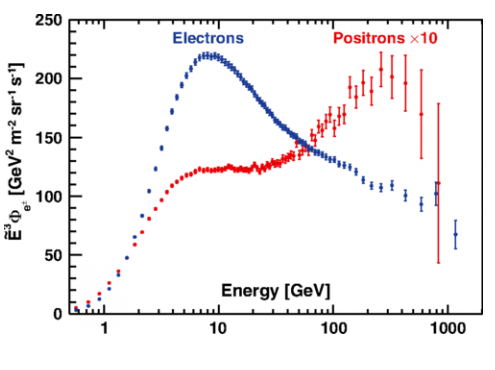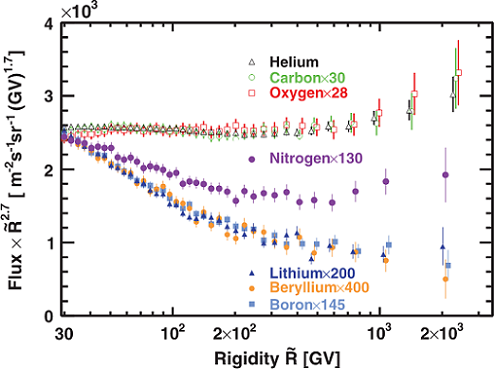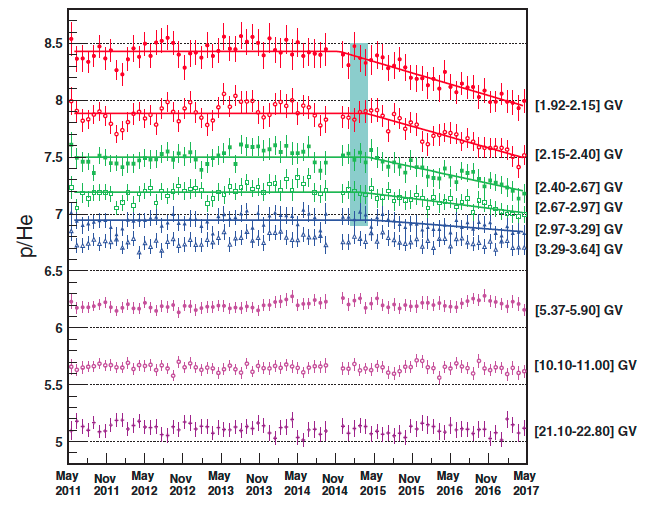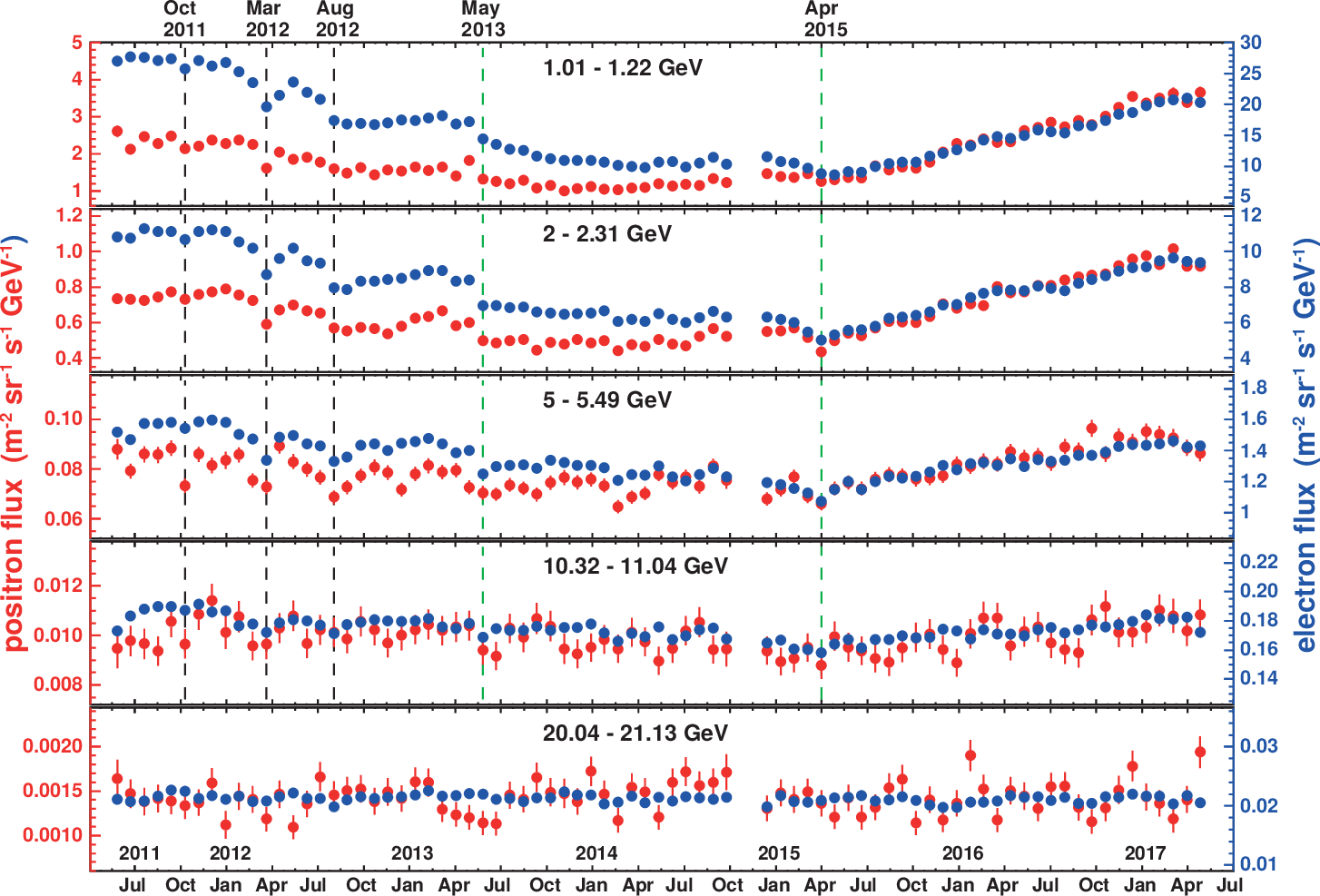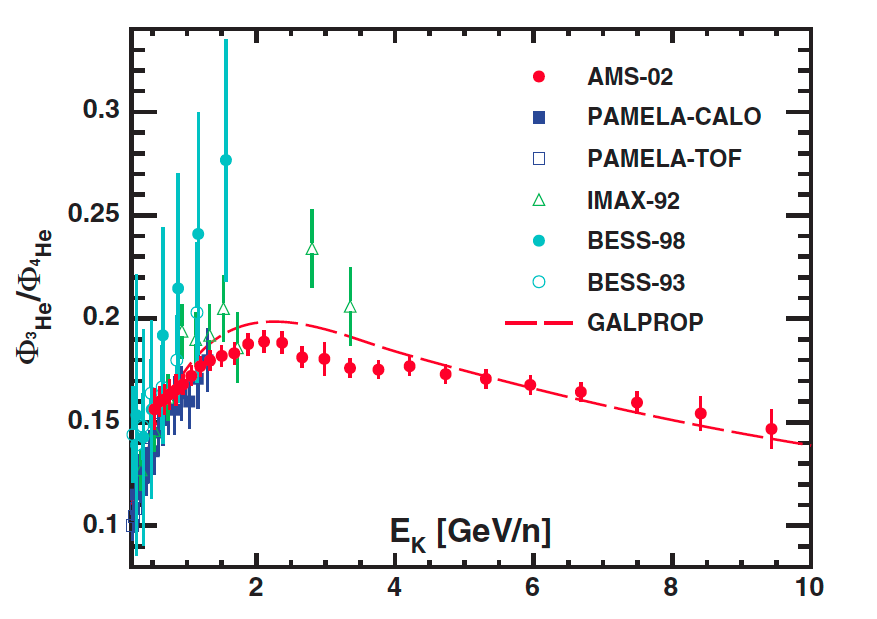|
AMS is a state-of-the-art particle physics detector, designed to operate as an external module on the International Space Station (ISS). It uses the unique environment of space to study the universe and its origin by searching for antimatter and dark matter while performing precision measurements of cosmic rays composition and flux.
The instrument was launched by the Space Shuttle Endeavour (STS-134) to the ISS on 16-May-2011, installed on the upper Payload Attach Point on 19-May-2011, and will operate on the ISS for the lifetime of it.
AMS-02 time on ISS since May 19th 2011, 9:46 a.m. UTC (5:46 a.m. EDT):
The layout of the AMS detector is illustrated in Fig.1, where the reconstructed path of a high energy electron detected in flight is also shown. The instrument consists of a permanent magnet and nine planes of silicon tracker measuring the momentum p, charge Z and rigidity R=p/Z of charged cosmic rays, four planes of time-of-flight counters, a transition radiation detector (TRD), a ring imaging Čerenkov detector (RICH), an electromagnetic calorimeter (ECAL), and an array of 16 anticoincidence counters. It operates continuously on the ISS and is monitored and controlled continuously from the ground.
More information about the mission is available at https://ams02.space
AMS has collected:
234,890,907,749
cosmic ray events
Last update: April 24, 2024, 11:03 PM
Latest AMS-02 data
The complete set of the AMS-02 published data is available for download at the SSDC Cosmic Ray Database. In the following, a selection of the latest and most significant AMS data is reported. - The most recent AMS results feature the measurement of the lepton components of cosmic rays, with the precise measurement of the galactic electron and positron differential fluxes[2], as reported in Fig.2. The different behaviour of the cosmic-ray electrons and positrons is clear evidence that most high energy electrons originate from different sources than high energy positrons.
- Fig.3 shows AMS measurements of differential fluxes for primary (He, C, O) and secondary nuclei (Li, Be, B) cosmic rays, and Nitrogen[4], which has both primary and secondary components. For display purposes only, the fluxes were rescaled as indicated.
- AMS also performed precise measurements of protons, the most abundant components of cosmic rays. In particular, thanks to its long exposure and the high collected statistics, AMS is monitoring in time the galactic cosmic ray flux and following its temporal variation in connection with solar activity. As shown in Fig.4 and Fig.5, AMS has already measured the differential flux temporal evolution for several species - protons, Helium, electrons and positrons - during the maximum of solar cycle 24 towards the current minimum[5][6].
- AMS has recently measured Helium isotopes, providing results for 3He and 4He fluxes as detected over the course of six years[1]. The two isotopes exhibit nearly identical variations with time due to solar modulation, with a significant long-term time dependence in the 3He/4He ratio below 4 GV. The rigidity dependence of the 3He/4He flux ratio is measured for the first time up to 15 GV, and it is shown in Fig.6.
AMS-02 publications
Properties of Cosmic Helium Isotopes Measured by the Alpha Magnetic Spectrometer
Phys. Rev. Lett. 123, 181102 (2019), View supplemental material and data (3He, 4He fluxes, 3He/4He ratios and their temporal dependences - 3He, 4He, 3He/4He) Towards Understanding the Origin of Cosmic-Ray Electrons
Phys. Rev. Lett.122, 101101 (2019), View supplemental material and data (positron fraction, e- fluxes) Editors' Suggestion
Towards Understanding the Origin of Cosmic-Ray Positrons
Phys. Rev. Lett. 122, 041102 (2019), View supplemental material and data Precision Measurement of Cosmic-Ray Nitrogen and its Primary and Secondary Components with the Alpha Magnetic Spectrometer on the International Space Station
Phys. Rev. Lett.121, 051103 (2018), View supplemental material and data (N flux, N/B and N/O flux ratios) Editors' Suggestion
Observation of Complex Time Structures in the Cosmic-Ray Electron and Positron Fluxes with the Alpha Magnetic Spectrometer on the International Space Station
Phys. Rev. Lett. 121, 051102 (2018), View supplemental material and data (e+ flux as a function of time and energy, e- flux as a function of time and energy, e+/e- ratio as a function of time and energy) Observation of Fine Time Structures in the Cosmic Proton and Helium Fluxes with the Alpha Magnetic Spectrometer on the International Space Station
Phys. Rev. Lett. 121, 051101 (2018), View supplemental material and data (p/He as a function of time and rigidity, p as a function of time and rigidity, He as a function of time and rigidity) Editors' Suggestion Featured in Physics
Observation of New Properties of Secondary Cosmic Rays Lithium, Beryllium, and Boron by the Alpha Magnetic Spectrometer on the International Space Station
Phys. Rev. Lett.120, 021101 (2018), View supplemental material and data (Li, Be, B fluxes and ratio) Observation of the Identical Rigidity Dependence of He, C, and O Cosmic Rays at High Rigidities by the Alpha Magnetic Spectrometer on the International Space Station
Phys. Rev. Lett. 119, 251101 (2017), View supplemental material and data (He, C, O fluxes and ratio) Editors' Suggestion Featured in Physics
Precision Measurement of the Boron to Carbon Flux Ratio in Cosmic Rays from 1.9 GV to 2.6 TV with the Alpha Magnetic Spectrometer on the International Space Station
Phys. Rev. Lett.117, 231102 (2016), View supplemental material and data (B/C as a function of rigidity or kinetic energy) Antiproton Flux, Antiproton-to-Proton Flux Ratio, and Properties of Elementary Particle Fluxes in Primary Cosmic Rays Measured with the Alpha Magnetic Spectrometer on the International Space Station
Phys. Rev. Lett.117, 091103 (2016), View supplemental material and data (pbar, pbar/p) Editors' Suggestion
Precision Measurement of the Helium Flux in Primary Cosmic Rays of Rigidities 1.9 GV to 3 TV with the Alpha Magnetic Spectrometer on the International Space Station
Phys. Rev. Lett.115, 211101 (2015), View supplemental material and data (He, p/He) Editors' Suggestion
Precision Measurement of the Proton Flux in Primary Cosmic Rays from Rigidity 1 GV to 1.8 TV with the Alpha Magnetic Spectrometer on the International Space Station
Phys. Rev. Lett. 114, 171103 (2015), View supplemental material and data Precision Measurement of the (e+ + e-) Flux in Primary Cosmic Rays from 0.5 GeV to 1 TeV with the Alpha Magnetic Spectrometer on the International Space Station
Phys. Rev. Lett. 113, 221102 (2014), View data Editors' Suggestion Featured in Physics
Electron and Positron Fluxes in Primary Cosmic Rays Measured with the Alpha Magnetic Spectrometer on the International Space Station
Phys. Rev. Lett. 113, 121102 (2014), View data Editors' Suggestion
High Statistics Measurement of the Positron Fraction in Primary Cosmic Rays of 0.5 500 GeV with the Alpha Magnetic Spectrometer on the International Space Station
Phys. Rev. Lett. 113, 121101 (2014), View data Editors' Suggestion Featured in Physics Physics Viewpoint
First Result from the Alpha Magnetic Spectrometer on the International Space Station: Precision Measurement of the Positron Fraction in Primary Cosmic Rays of 0.5-350 GeV
Phys. Rev. Lett. 110, 141102 (2013), View supplemental material and data
|
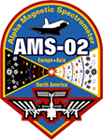
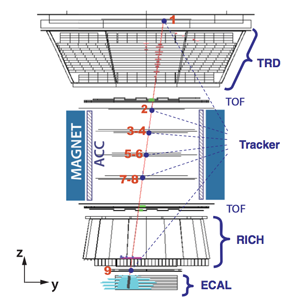
Fig.1: A high energy electron
reconstructed in AMS-02
|
|
|




